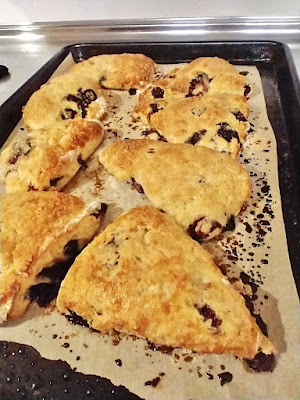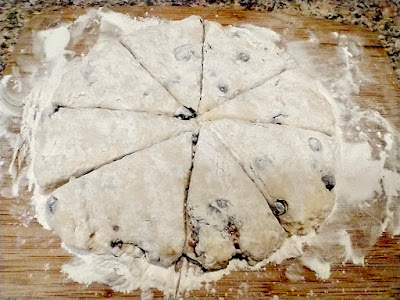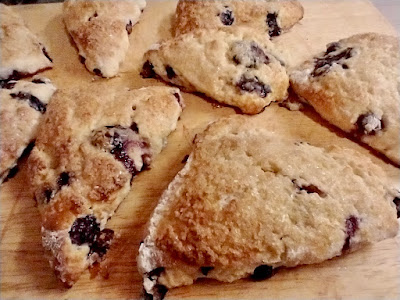
Recipe: Blueberry lemon scones made with yogurt

Blueberry lemon scones are a delicious treat
for brunch or a coffee break.
(Photos: Debbie Arrington)
|
Scones are like buttery biscuits with less work. Kneading or over-stirring makes tough, chewy scones instead of a treat that melts in your mouth.
Using a food processor to cut the butter and lemon zest into the dry ingredients creates a finely textured crumb with tiny bits of lemon flavor in every bite. Blueberries (fresh or frozen, defrosted) add bursts of juicy flavor.
Treat this sticky dough gently to keep it tender. That includes when folding in the blueberries.
Blueberry lemon scones
Makes 8 servings
Ingredients:
2 cups all-purpose flour
1 teaspoon salt
1 tablespoon baking powder
2 tablespoons white sugar
2 tablespoons lemon zest, finely grated
6 tablespoons butter, cut into 6 pieces
2 eggs
¾ cup plain yogurt
1 cup blueberries
Flour for dusting

|
For egg wash:
1 egg
1 tablespoon water
3 tablespoons Demerara or white sugar
Instructions:
Preheat oven to 450 degrees F.
In a food processor, mix together flour, salt, baking powder, sugar and lemon zest; pulse to combine.
Add butter; pulse until butter is combined with dry ingredients; about 20 pulses. Set aside.
In a large bowl, beat 2 eggs. Add yogurt and combine with a few quick strokes. Add dry ingredients, mixing just until combined to form a sticky dough. Gently fold in blueberries.
Put dough on lightly floured board. With floured hands, gently pat dough into an 8-inch round about 1 inch thick. With a floured knife, cut round into 8 wedges.
Transfer wedges onto baking sheet lined with parchment paper.
Make egg wash. Beat remaining egg together with 1 tablespoon water. With a pastry brush, brush egg wash over top of wedges. Sprinkle Demerara or white sugar over egg wash.

|
Bake scones in a 450-degree oven until golden brown, about 12 to 15 minutes.
Remove from oven. Let cool for 5 minutes on baking sheet, then transfer to a rack. Let cool for 10 more minutes, then serve.
Serve warm.
Comments
0 comments have been posted.Sacramento Digs Gardening to your inbox.
Sites We Like
Garden Checklist for week of April 21
This week there’s plenty to keep gardeners busy. With no rain in the immediate forecast, remember to irrigate any new transplants.
* Weed, weed, weed! Get them before they flower and go to seed.
* April is the last chance to plant citrus trees such as dwarf orange, lemon and kumquat. These trees also look good in landscaping and provide fresh fruit in winter.
* Smell orange blossoms? Feed citrus trees with a low dose of balanced fertilizer (such as 10-10-10) during bloom to help set fruit. Keep an eye out for ants.
* Apply slow-release fertilizer to the lawn.
* Thoroughly clean debris from the bottom of outdoor ponds or fountains.
* Spring brings a flush of rapid growth, and that means your garden is really hungry. Feed shrubs and trees with a slow-release fertilizer. Or mulch with a 1-inch layer of compost.
* Azaleas and camellias looking a little yellow? If leaves are turning yellow between the veins, give them a boost with chelated iron.
* Trim dead flowers but not leaves from spring-flowering bulbs such as daffodils and tulips. Those leaves gather energy to create next year's flowers. Also, give the bulbs a fertilizer boost after bloom.
* Pinch chrysanthemums back to 12 inches for fall flowers. Cut old stems to the ground.
* Mulch around plants to conserve moisture and control weeds.
* From seed, plant beans, beets, cantaloupes, carrots, corn, cucumbers, melons, radishes and squash.
* Plant onion sets.
* In the flower garden, plant seeds for asters, cosmos, celosia, marigolds, salvia, sunflowers and zinnias.
* Transplant petunias, zinnias, geraniums and other summer bloomers.
* Plant perennials and dahlia tubers for summer bloom.
* Mid to late April is about the last chance to plant summer bulbs, such as gladiolus and tuberous begonias.
* Transplant lettuce seedlings. Choose varieties that mature quickly such as loose leaf.